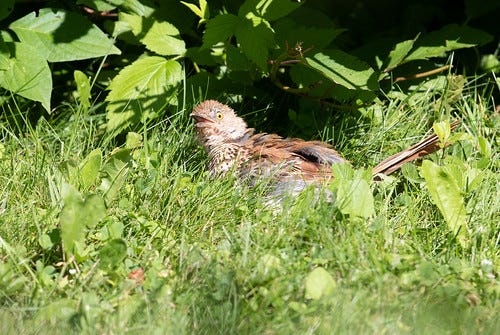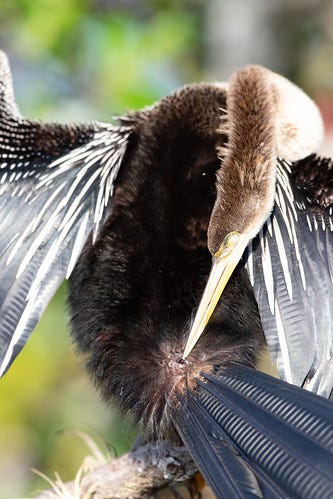Sun-Bathing, Blue Jay Style
If you see a Blue Jay panting and keeled over on one side, it's almost certainly not sick—just sun-bathing.
(Listen to the radio version here when I record it tomorrow.)
Last weekend, an email from a guy named Keith Peterson sent me down Memory Lane. In the summer of 1979 while Russ and I were living in Madison, Wisconsin, I raised a baby Blue Jay I called Ludwig. He was a dear little guy who taught me a lot about Blue Jays.
One morning after Ludwig was getting pretty good at flying, while I was pouring my Rice Krispies, out popped a bright red wind-up propeller toy, about 2 or 2-1/2 inches in diameter. I found a rubber band, wound up the propeller, and shot it up in our dining room. Instantly, Ludwig flew up and grabbed it in mid-air, and carried it in his beak straight to me. That quickly became a game, with him tirelessly bringing it back to me like a well-trained golden retriever so I could send it right back up again.
I’d rescued Ludwig from a dog—a golden retriever, no less—when he was a young fledgling. He was perfectly healthy and strong, destined to be released into the wild, and so as soon as he could flit about at all, I started taking him outside every day to our apartment building’s small backyard so he could spend minutes, and then hours at a stretch, figuring out the big world. He needed to develop his flight skills in a place where he could land in bushes and trees, not on tables and chairs. Soon I was playing our propeller game with him outside.
Our apartment building was small—just two stories with five apartments (ours was the basement unit)—sandwiched between a huge brick building and a building similar to ours. A couple of big shade trees were near the back, and a thick hedge ran along one side of the yard and the alley behind. I had to aim the propeller straight up to keep it from getting caught in a tree or landing on our roof. One warm, sunny day I misjudged, and the little propeller ended up on the roof. Ludwig flew straight up for it, but the moment he alighted on the hot shingles, he collapsed, tilting to one side, one wing drooping low, his crest straight up, his beak wide open. I called and called but he didn’t move. I’d never seen anything like this and thought he’d had a stroke, heart attack, or something equally dire.
Russ wasn’t home, so on sheer adrenalin, I ran into the storage room where our landlord kept a ladder, lugged it out, and climbed to the top rung. Ludwig was out of reach and still not responding to my voice. I’m terribly afraid of heights but without even thinking, I started crawling up on the roof itself. The moment I touched him, he shook his head, flew down to a shrub, and started preening.
Now that the danger had passed, my fear of heights kicked in at full force. The last 8 inches or so between my outstretched hand and the propeller felt insurmountable, so I left it on the roof. I was sweating and shaking by the time I made it to the ground and plopped down on all fours on the grass. Within a minute or so, Ludwig flew back to the roof, grabbed the propeller, and brought it to me, still on my knees.
Ludwig seemed fine but I was scared that there was something seriously wrong with him, so I called my treasured friend Malcolm McDonald, who worked for the U.S. Fish and Wildlife Service and had handled and even lived with baby corvids. When I described the situation, he chuckled and said Ludwig had just been “sunning,” or sunbathing. He said that while birds are sunning they seem to be in a trance-like state and assured me that there was absolutely nothing wrong with him. He mentioned that the first time he ever saw a bird sunning, he also thought it was on death’s door.
I should have known! I vaguely recalled reading about sunning in one of my ornithology classes.
Sure enough, it was listed in the indexes of both my ornithology textbooks, though one had it as a subentry under “behavior.” When I took those classes in 1975 and 1976, I read the assigned textbook cover to cover, but in both cases, the entire discussion of sunning was limited to one short paragraph in the book without any mention in the lectures. Neither textbook mentioned Blue Jays or other species sunning, and neither showed the behavior in a photo. Nevertheless, I was embarrassed that sunning had slipped my mind.
When birds sun, they raise their back and neck feathers to allow the sun to reach their skin. They usually open their beak, too—that probably helps maintain the proper internal body temperature.

Sunlight on the skin stimulates Vitamin D production, sunlight on the exposed uropygial (or oil) gland just above the tail stimulates preen-oil production, and the light and heat probably get any lice and mites scooting around. The moment a bird stops sunning, it retreats to a secluded spot and preens vigorously, combing and pulling out debris and ectoparasites, and smearing oil from the uropygial gland onto their feathers.

At the time Ludwig and I had our backyard adventure, he’d never been outdoors without me, so I know he’d never sunned before. My guess is that touching the hot, sunny roof elicited the behavior unbidden. But being in that trancelike state, sunning birds are extremely vulnerable to predators, so I suspect birds must quickly figure out how and where to so safely.
A similar behavior is anting—sitting on an anthill and either picking up ants to smear on skin and feathers or collapsing into the same posture as sunning so ants will crawl all over their feathers. Ant bodies are laced with formic acid, which may act as an insect repellent. The first time my Blue Jay Ludwig picked up an ant in our house, he instantly spit it out, raised his crest, and shook his head—the formic acid taste must have surprised him. But then he cocked his head, moved his tongue in and out a moment, grabbed the ant again, and started smearing it on his feathers. Apparently the bitter taste of the ant elicited active anting.
Passive anting—allowing ants to crawl over the body—probably offers the same benefits as both active anting and sunning—most anthills are in the open, so the bird soaks up some rays and a dose of formic acid at the same time.
I first witnessed passive anting by Blue Jays in the mid-90s. A front lawn down my block had both a big bare spot crawling with ants and a spruce tree where a pair of Merlins were nesting. Several times, I saw a Blue Jay fly up above the nest and hover, apparently checking whether the Merlin was in or out of the nest before dropping to the anthill, toppling to one side, and going into that weird trance. I could never see whether the Merlin was on or off the nest, so I don’t know if an empty nest told the jay the coast was clear or if a Merlin on the nest assured the jay that the falcon was too busy incubating to pose a threat.
In the 1990s, I had a licensed education Blue Jay named Sneakers.
Sneakers was mostly an indoor bird, and when going to speaking events, I transported her in a cage. Several times on sunny days as I was walking between a venue and my car, she toppled over into that sunning position. Unless I was in a big hurry, I’d set the cage down for a minute or two, letting her enjoy the sensation until she stopped of her own accord. When passersby noticed her, they always thought she was dying, so I’d have to explain what was happening. But I never got a photo of her, Ludwig, nor any other Blue Jay sunning.
Anyway, on Sunday, Keith Peterson sent me a photo of a Blue Jay sunning on his Eden Prairie deck.
He said, “I’m thinking it’s either injured, sick, or maybe just basking in the sun,” so he had way more insight about this cool behavior than I did when I first saw it. On Monday, he sent another photo, from a different angle.
I was thrilled to see Keith’s photos because even though I’ve seen more Blue Jays sunning than any other species, I’ve never managed to get a picture. The only photos I have of sunning birds in my own yard are of a robin, Brown Thrasher, and chickadee.
I’m always delighted to hear from listeners and readers. Missives like Keith Peterson’s remind me of things other people might be wondering about, too. Thanks so much, Keith!













Great column today! I hope to see that behavior some today. I was a zoology major at University of MN and took ornithology with Dwain Warner those same years as you took your classes with the exact same texts.
Down here on Gladstone St I built a dry creek bed with landscaping in our new backyard in 2018. The next year I witnessed a Crow "enjoying" an ant bath on an open space between the rocks on one side of that dry creek bed. I thoroughly enjoyed your story about Ludwig and the observations shared!